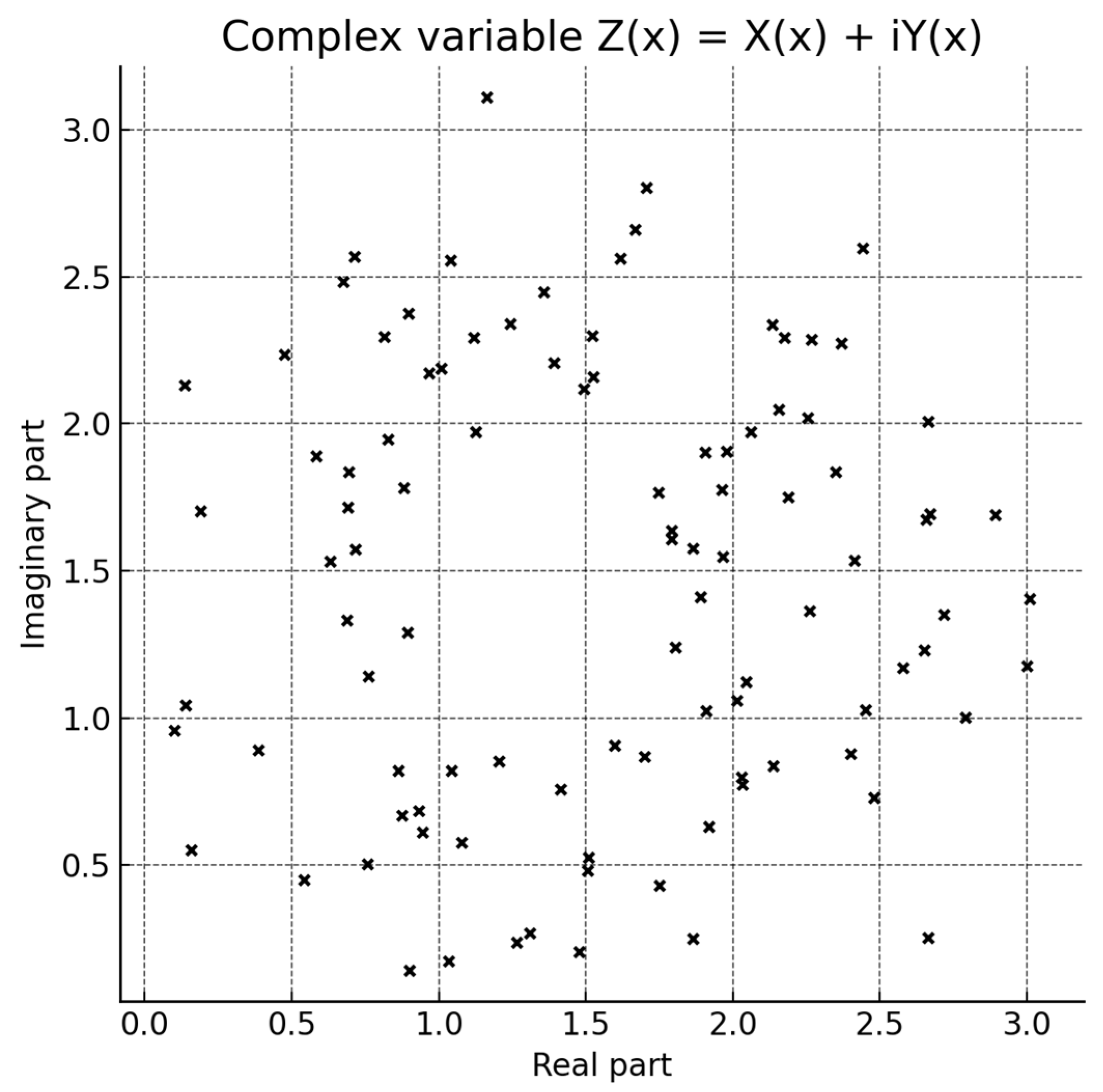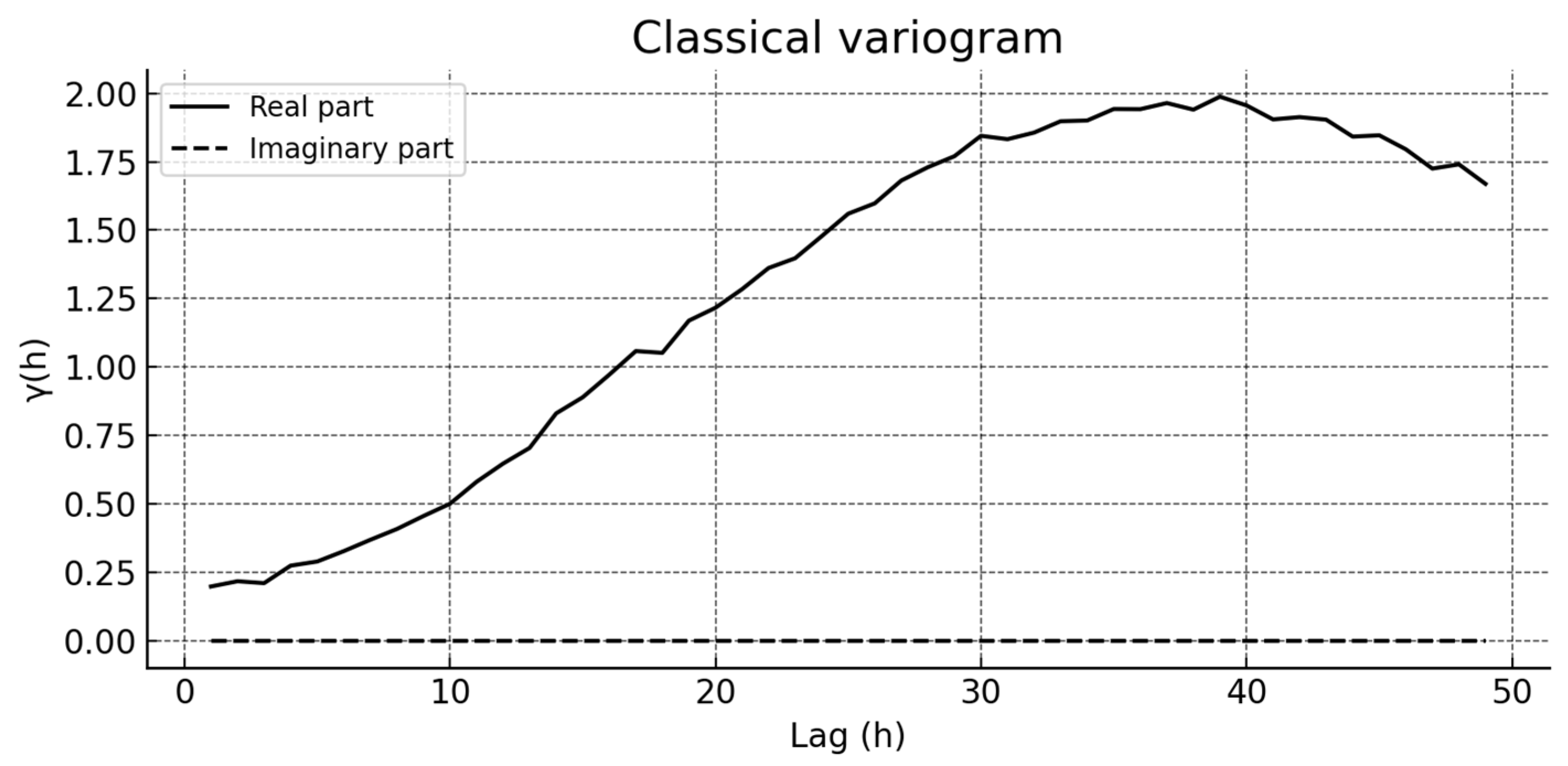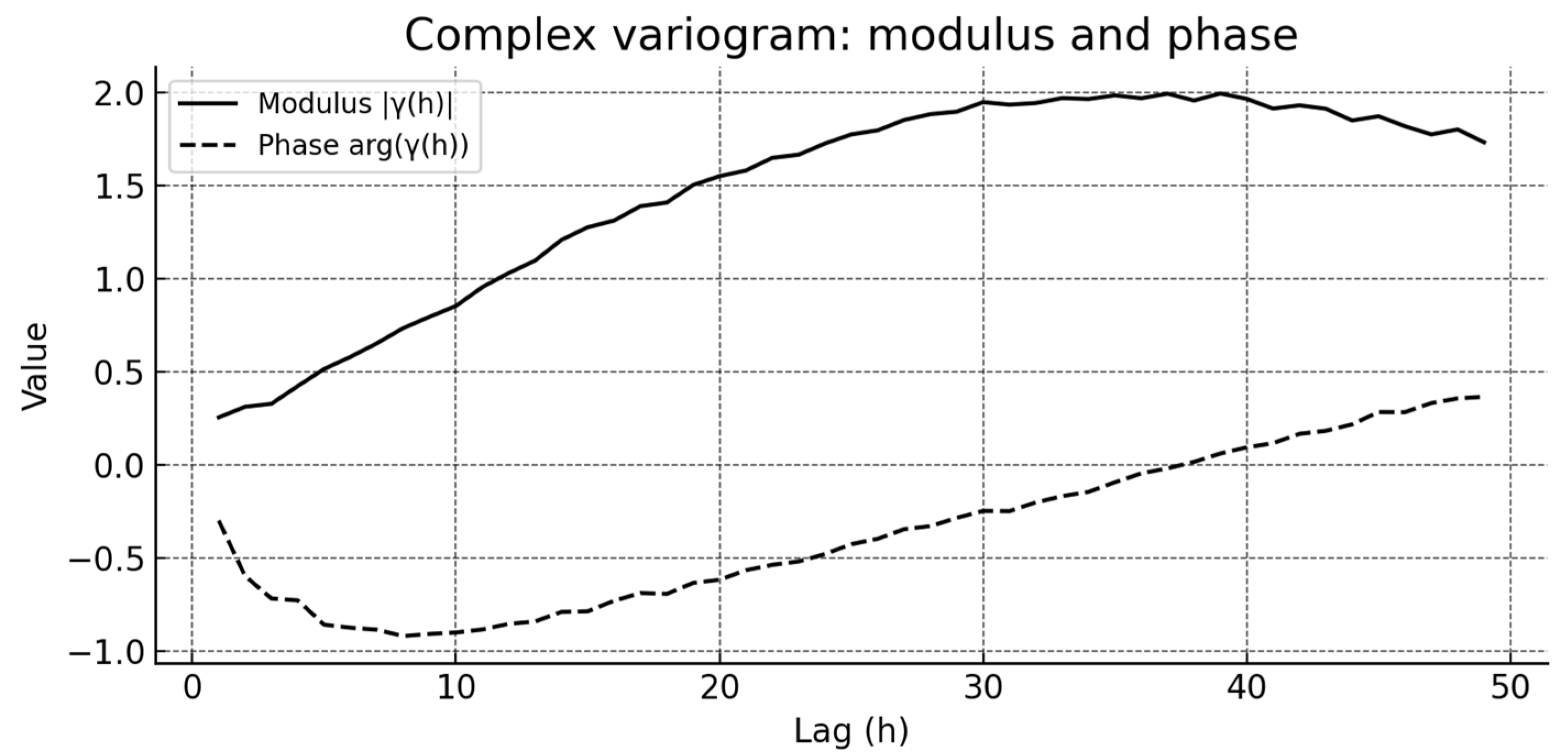1. Introduction
The use of complex-valued variables in geostatistics remains an emerging and largely unexplored area, particularly in the field of soil science. While the theory of complex-valued random fields and covariance functions has been addressed in several earlier studies [
1,
2,
3,
4,
5,
6], its application in applied geostatistics remains minimal. In particular, Schreier and Scharf [
1] and Picinbono and Bondon [
2] come from signal theory, with data types and modelling frameworks that differ from those encountered in geosciences. In geostatistics, a regionalized variable is the fundamental concept: it is a function defined over a spatial domain whose values exhibit both a deterministic trend and a stochastic component, the latter described through spatial correlation. A regionalized variable may be real-valued or complex-valued, depending on the nature of the property under study, and its analysis is carried out in the space (and sometimes space–time) domain. While both domains share concepts such as correlation, covariance, and stationarity, their modelling objectives and assumptions differ: signal theory often focuses on deterministic–stochastic decomposition in the time–frequency domain, whereas geostatistics centers on spatial correlation structures and the interpolation or simulation of values over a geographic domain. Within geostatistics, Lajaunie and Béjaoui [
3] and De Iaco et al. [
4] made valuable theoretical contributions, whereas De Iaco [
5] focused mainly on software and demonstrations for atmospheric and environmental vector fields. Despite these efforts, the complex-valued framework has not yet found widespread practical adoption.
This study aims to promote the practical application greater interest in the practical use of complex-valued analysis within geostatistics. By centring the discussion on variograms—well-established and familiar to practitioners, it seeks to offer a more accessible and illustrative framework than purely theoretical treatments. Such an approach may encourage practitioners to explore and adopt methods for complex-valued variables in real-world applications. The methodological framework draws on the traditional formalism long established in classical geostatistics textbooks [
7,
8,
9,
10,
11,
12,
13,
14,
15,
16,
17,
18], in line with the conventions presented, for example, by Webster and Oliver [
7], Hengl [
8], Chiles and Delfiner [
9], and Zawadzki [
10]. Beyond its theoretical contribution, the framework offers a methodological reference for soil scientists, facilitating the interpretation of complex-valued measurements where both amplitude and phase provide complementary information on soil formation and alteration processes.
The paper also highlights the potential of complex-valued variograms in soil studies, in particular, using magnetic susceptibility measurements [
19,
20,
21]. Complex magnetic susceptibility, which provides both real and imaginary components, represents a promising data source [
22,
23]. Exploring this kind of data through a variogram-based framework could help bridge the gap between theoretical advancements and field-oriented research.
By framing this classification within an application-oriented perspective, the present work offers a generalizable yet practitioner-friendly extension of geostatistics to complex-valued variables, particularly for datasets where both magnitude and phase carry relevant information. The approach outlined here may be found in geology, advanced soil sensing, magnetometry, environmental monitoring, remote sensing, and related fields. For practical reasons, two main types of complex-valued variograms are distinguished:
Type I—The real variogram of complex-valued variables, which can be expressed in two alternative but related forms:
(a) The classical form (Form R.I), identical to that for real-valued variables, yielding real, nonnegative values;
(b) The covariance-based form (Form R.II), also yielding real, nonnegative values.
Type II—The covariance-based form that yields complex-valued variograms (Form C.I).
These labels (R.I, R.II, and C.I) are used consistently throughout the paper for clarity.
2. Materials and Methods
Data were generated using a covariance-based spatial process implemented in R software (version 4.5.0; R Core Team 2023 [
24]).
A one-dimensional complex-valued spatial variable was synthetically generated over a regular grid , comprising 100 equally spaced points. The components were modeled as independent realizations of second-order stationary Gaussian random fields, each governed by an exponential covariance function. This approach is widely applied in geostatistics and environmental modeling for simulating spatial variability under known correlation structures.
The covariance structure adopted for both real and imaginary components is defined by:
where
,
h is the spatial lag,
denotes the marginal variance (here set to 1), and a is the correlation length, fixed at 1.2. The covariance model ensures a short-range spatial dependency with continuous but non-differentiable realizations typical of natural environmental processes. The exponential covariance model ensures that the complex covariance is Hermitian positive-definite, meaning that it remains symmetric with respect to complex conjugation and thus guarantees numerical stability of the kriging system [
9,
15].
Realizations of
and
Y(
x) were generated using standard numerical routines for simulating Gaussian random vectors with specified covariance matrices. The full covariance matrix
of size 100 × 100 was constructed using Equation (1), and a single realization was obtained by drawing two independent standard normal vectors:
and computing
where
is the Cholesky factor of
, such as
.
This method preserves the exact covariance structure and is recommended for generating spatially correlated fields.
To guarantee physical interpretability (e.g., avoidance of negative values in magnitude-based interpretations), a constant shift c was applied uniformly to both components:
This transformation ensures that values are strictly positive, preventing artificial zero crossings in the further analysis of the modulus and phase.
Although real soil data were not analyzed here, the simulated fields were generated using realistic covariance parameters typical of soil magnetic properties, ensuring direct transferability of the framework to measured datasets.
3. Results and Discussion
3.1. The Real-Valued Variogram of Complex Variables (R.I)
This section compares two definitions of variograms for complex-valued variables: the classical definition and its covariance-based form. An analysis of the mathematical formulation is provided below, along with its interpretation.
The classic form of variogram (Form R.I):
where
denotes the variogram as a function of lag
,
is a complex-valued spatial random variable defined at location
,
Z(
x +
h) is the same variable at a location displaced by lag
,
denotes the complex modulus,
E[⋅] is the mathematical expectation operator.
In practical terms, the assumption of stationarity can be preliminarily verified by examining the stability of the mean phase. A moving-window average of arg{Z(x)} can indicate whether the mean phase remains constant. When local phase variations occur, the intrinsic form (R.I) should be preferred; otherwise, the covariance-based form (C.I) is applicable.
This definition generalizes the traditional variogram to complex-valued variables by taking the expectation of the squared modulus of the increment. It yields a real and non-negative quantity consistent with the conventional understanding of variability. However, it discards any phase-related information inherent in complex processes.
An alternative, more informative approach uses the covariance function. The variogram in this form (Form C.I) is defined as
where
denotes the complex covariance function. In this case, the variogram is itself a complex-valued function. The real part recovers the classical structure, while the imaginary part encodes asymmetries, spatial shifts, and phase information. This richer formulation facilitates the analysis of directional effects and phase-related structures, which are relevant in applications such as radar imaging, electromagnetic field interpretation, and advanced remote sensing. Both formulations can be used complementarily: the classical form provides a general measure of spatial variability, while the covariance-based version retains the full complex structure, including information on phase behavior.
3.2. Linking the Classical and Covariance-Based Variogram Formulations
The covariance-based definition of the variogram can be derived analytically from the classical formulation by expanding the squared increment and invoking second-order stationarity. This derivation reveals their mathematical equivalence and clarifies the interpretation of the imaginary component within the complex domain.
Let Z(x) ∈ ℂ denote a complex-valued second-order random field. Two standard forms of the variogram are considered, as defined in Equations (1)–(3).
The random field Z(x) is assumed to be second-order stationary. This implies
In the context of complex-valued fields, we define the conjugate covariance function as
Starting from the classical definition:
Expanding the squared modulus:
Taking expectations under stationarity:
Substituting into the definition:
one obtains the R.II form of the variogram.
Thus, the real-valued forms (R.I and R.II) are equivalent and correspond to the real part of the complex covariance-based variogram (C.I):
where
In geostatistics, the variogram is traditionally the primary tool for describing spatial structure. Compared with covariance, the variogram can be defined and estimated under weaker assumptions. In particular, the intrinsic hypothesis requires only a constant mean and an increment variance that depends solely on the lag vector h; it does not require a well-defined covariance. This flexibility is central in practice. However, for variogram forms defined directly via covariance, second-order stationarity is needed, and the benefits of the intrinsic hypothesis cannot be used.
3.3. Remarks on Classical Stationarity Hypotheses for Real-Valued Random Functions
In the strict sense, a random function is stationary of the first order when all finite-dimensional joint distributions are invariant under translations in space. This means that if we shift the entire set of sampling locations by any vector h, the joint probability distribution of the values remains the same.
Formally, for any collection of spatial locations and any shift vector h, the joint distribution of is identical to the joint distribution of (Z(x1 + h), Z(x2 + h), …, Z(xn + h)). An immediate consequence of this property is that, if the mean exists, it must be constant over the entire domain: E[Z(x)] = m for all x. It is important to note that strict stationarity does not require the existence of a finite variance or covariance—it is a purely distributional property. This makes it the most general, but also the least restrictive, of the common stationarity assumptions. However, in practice, geostatistical modelling often requires additional assumptions (such as finite variance) to work with variograms or covariances, which are not guaranteed under strict stationarity alone.
The mean is constant and the covariance depends only on the lag: , so the (semi)variogram can be written as: This definition requires that the process has a finite second moment, ensuring the existence of the covariance function. Second-order stationarity is a much weaker condition than strict stationarity, as it does not require the invariance of the entire joint distribution under translations, but it is still stronger than the intrinsic hypothesis. It enables a full characterization of spatial dependence through covariance, which in turn allows for more detailed modelling approaches such as kriging with known covariance models. However, in practice, this assumption can be too restrictive for irregular or heavy-tailed spatial data.
The mean is constant (equivalently, increments have zero mean) and the increment variance depends only on the lag: ). This hypothesis assumes a constant mean and that the variance of increments depends only on the lag vector. Crucially, it is formulated directly in terms of the variogram, which makes it possible to model the spatial structure without defining the full covariance function. It is a weaker assumption than second-order stationarity, as it only requires finite variances of increments rather than the complete covariance structure. This makes the variogram-based approach applicable even in situations where modelling the covariance is difficult or unreliable.
3.4. Stationarity Hypotheses for Complex-Valued Random Functions—Forms R.I, R.II, and C.I of Variograms
Form R.I (increment-based empirical variogram; real-valued for complex variables). The variance of increments of Z as a function of the lag, yielding a real, non-negative value: . Stationarity requirement: the intrinsic hypothesis is sufficient (constant mean; increment variance depends only on h). No covariance is required.
Form R.II (covariance-based; real-valued for complex variables). First define the Hermitian covariance: . Then the variogram is . This definition requires knowledge of the full covariance function and, therefore, cannot be applied in situations where the process satisfies only the intrinsic hypothesis. In other words, if second-order stationarity is not fulfilled (lack of a constant expected value or lack of finite covariance), the R.II variogram is not defined. For this reason, the R.II form is used only in analyses where the data is sufficiently regular and covariance modelling is both feasible and justified. Its advantage lies in the possibility of directly exploiting the Hermitian properties of covariance and in the unambiguous link to the complete description of the process’s correlation structure.
Form C.I (covariance-based; complex-valued for complex variables). Full complex variogram using the same Hermitian covariance: . Hermitian symmetry: . This definition requires second-order stationarity in the complex sense, which means the process must have a constant complex-valued mean and a finite Hermitian covariance function for all . Because the formulation depends explicitly on the covariance, it cannot be applied when only the intrinsic hypothesis holds—in such cases, the variogram is undefined. Consequently, form C.I is applied only in situations where the data are sufficiently regular and the modelling of the full Hermitian covariance is both feasible and meaningful.
Its main advantage is the ability to represent both magnitude and phase relations in the spatial structure, while preserving the symmetry properties specific to complex-valued random functions.
This allows a direct link between the variogram and the complete description of spatial correlations in both the real and imaginary components, making it a powerful tool in contexts where phase information is important.
Ultimately, it is worth noting that a key strength of variogram-based analysis is the possibility of utilizing the intrinsic hypothesis, which enables modeling under weaker assumptions by relying on the variances of increments rather than the full covariance structure. This flexibility is fundamental for the applicability of form R.I. By contrast, forms R.II and C.I are defined directly from the (Hermitian) covariance function, which requires second-order stationarity; in these cases, the intrinsic hypothesis cannot be applied. In practice, the application of complex-valued variograms to real soil data necessitates careful consideration of data quality, measurement consistency, and potential departures from intrinsic or second-order stationarity, which can impact the stability of covariance-based estimators.
3.5. Simulation Results
Figure 1,
Figure 2,
Figure 3,
Figure 4,
Figure 5,
Figure 6,
Figure 7 and
Figure 8 provide visualizations of the simulated complex-valued dataset and its spatial structure.
Figure 1 presents the variable
in the complex plane, while
Figure 2 and
Figure 3 depict the spatial profiles of the real component
and imaginary component
, respectively.
Figure 4,
Figure 5,
Figure 6,
Figure 7 and
Figure 8 present the results of complex variogram analyses in both Cartesian and magnitude–phase representations, allowing for direct comparison between the intrinsic-based and covariance-based formulations. Together, these figures offer complementary perspectives on the same underlying spatial relationships, highlighting differences between the real-valued and complex-valued approaches without duplicating details already included in the captions. This structured presentation is intended to guide the reader from raw data visualization through to the interpretation of variogram behavior, thereby supporting a comprehensive understanding of the methodological framework.
The following
Figure 4,
Figure 5,
Figure 6,
Figure 7 and
Figure 8 illustrate the comparative behaviour of the three complementary formulations of the variogram—R.I, R.II, and C.I—applied to simulated complex-valued soil data. Together, they demonstrate how the transition from real-valued to complex-valued representations enriches the description of spatial variability and provides additional interpretive depth relevant to soil studies.
In
Figure 4, the separate real-valued variograms of the real and imaginary components (Form R.I) show their individual spatial structures, reflecting how distinct soil processes can produce variability at comparable correlation ranges. This form corresponds to analysing each measurable attribute—such as magnetic and geochemical responses—independently under the intrinsic hypothesis.
Figure 5 combines both components into a single real-valued variogram of the complex variable (Form R.II), which represents the overall magnitude of spatial variability. This form is analogous to conventional geostatistical analysis of scalar soil properties, yet it already integrates the joint spatial contribution of both physical dimensions of the complex variable.
The complex covariance-based formulation (
Figure 6 and
Figure 7, Form C.I) extends this description by incorporating phase relationships. Its real and imaginary parts reveal not only the strength of spatial dependence but also potential directional asymmetries or phase shifts, which can conceptually correspond to soil transformation or anthropogenic disturbance processes that alter the local magnetic or chemical environment.
Finally,
Figure 8 visualizes the modulus and phase of the C.I variogram, illustrating how both the intensity and direction of spatial dependence evolve with distance. This phase-related behaviour, although derived from simulated data, exemplifies how complex-valued geostatistics can uncover subtle interactions between coexisting soil properties that remain hidden in purely real-valued analyses.
4. Conclusions
The results indicate that, while both the real-valued (R.I) and complex covariance-based (C.I) formulations of the variogram can be applied to complex-valued variables, their practical use differs. The classical (intrinsic-based) form aligns with the intrinsic hypothesis, making it applicable in a wider range of situations, including cases where the global variance is undefined. However, to fully benefit from this flexibility in soil studies, it is often most practical to analyze the real and imaginary components separately. This approach enables soil scientists to retain the advantages of the intrinsic hypothesis without imposing stronger stationarity requirements.
The covariance-based form, by contrast (C.I.), preserves phase information and allows for the detection of directional effects and asymmetries, which may hold diagnostic value in soil and environmental interpretation but require further study to be fully understood. Further theoretical development is needed to extend geostatistical tools for complex-valued variables, ensuring they can be robustly applied in real-world soil research. The findings presented here are intended to serve as a practical reference for soil scientists, offering guidance on when and how to apply complex-valued variograms. However, while the theoretical framework presented here provides a necessary basis for extending geostatistical analysis to complex-valued soil variables, its implementation on real datasets will require further testing under field conditions to assess robustness, sensitivity to noise, and parameter stability.













